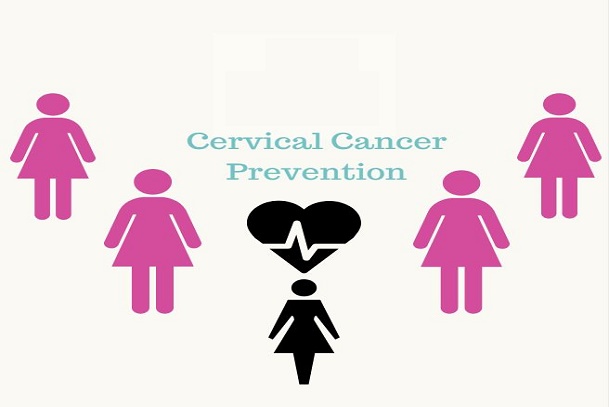 Wash your hands regularly and wear a face mask.
Learn more
Wash your hands regularly and wear a face mask.
Learn more

How To Prevent Cancer of The Cervix
In preventing cervical cancer, there are two forms of preventions: Primary and Secondary form of cervical cancer prevention.
This form of prevention involves protection against risk factors and enhancing the protective factors. The risk factors are anything that increases the chance of developing cancer; while anything that decreases the chance of developing cancer is called a cancer protective factor.
The risk factor associated with cervical cancer includes Human Papilloma Virus (HPV) infections, smoking, child bearing etc.
Cervical cancer is almost always caused by human papillomavirus (HPV) infection that is spread through sexual contact. There are more than 80 types of human papillomavirus and about 30 of these can infect the cervix. HPV types 16 and 18 are most often linked to cervical cancer.
The risk of HPV infection is higher in women who become sexually active before age 18 and in women who have had 6 or more sexual partners.
Most of the time, the body’s immune system can fight the HPV infection before cancer forms. Only a very small number of women infected with HPV develop cervical cancer.
Preventive Measure against HPV is the HPV Vaccine. Vaccines that protect against HPV infection greatly reduce the risk of cervical cancer. These vaccines do not protect women who are already infected with HPV. These vaccines have been shown to prevent infection with the types of HPV that cause most cervical cancers. Protection against HPV infection lasts for 6 to 8 years. It is not known if the protection lasts longer. Getting the HPV vaccine while pregnant, does not have any harmful effect on the pregnancy. Although the HPV vaccine can significantly reduce the risk of cervical cancer, it does not guarantee that recipient will not develop the condition.
Three HPV vaccines are now being marketed in many countries throughout the world - a bivalent, a quadrivalent, and a nonavalent vaccine. All three vaccines are highly efficacious in preventing infection with virus types 16 and 18, which are together responsible for approximately 70% of cervical cancer cases globally. The vaccines are also highly efficacious in preventing precancerous cervical lesions caused by these virus types. The quadrivalent vaccine is also highly efficacious in preventing anogenital warts, a common genital disease which is virtually always caused by infection with HPV types 6 and 11. The nonavalent provides additional protection against HPV types 31, 33, 45, 52 and 58. Data from clinical trials and initial post-marketing surveillance conducted in several continents show all three vaccines to be safe.
The primary target group in most of the countries recommending HPV vaccination is young adolescent girls, aged 9-14. For all three vaccines, the vaccination schedule depends on the age of the vaccine recipient.
A 3-dose schedule of the HPV vaccine remains necessary for those known to be immunocompromised and/or HIV-infected. A cervical screening test is still mandatory, even after the vaccine.
Among women who have had 7 or more full-term pregnancies have an increased risk of cervical cancer.
Preventive Measures includes Family Planning and reduction in the numbers of children.
Among women who are infected with HPV, those who have used oral contraceptives for 5 to 9 years have a risk of cervical cancer that is 3 times greater than that of women who have never used oral contraceptives. The risk is 4 times greater after 10 or more years of use. In women who stop taking oral contraceptives, over a 10 year period, the risk of cervical cancer returns to that of women who never used oral contraceptives.
Preventive Measures is avoiding prolonged use of oral contraceptives. Use other measures such as barrier methods (Intra uterine contraceptive device on long term and condom on short term).
Women can reduce their chances of getting cervical cancer by not smoking. People who smoke are less able to get rid of the HPV infection from the body, which can develop into cancer. Among women who are infected with HPV, those who either smoke cigarettes or breathe in secondhand smoke have an increased risk of cervical cancer. The risk increases with the number of cigarettes smoked per day and how long the woman has smoked. Current and former smokers have 2 to 3 times the risk of cervical dysplasia and invasive cervical cancer.
Preventive Measure is either to avoid or stop both active and passive smoking.
The protective factor associated with cervical cancer prevention includes the following:
Most cases of cervical cancer are linked to an infection with certain types of Human Papilloma Virus (HPV). HPV can be spread through unprotected sex, so using a condom can reduce the risk of developing the infection.
However, the virus is not just passed on through penetrative sex: it can be transmitted during any type of sexual contact. This includes any skin-to-skin contact between genitals; oral, vaginal or anal sex; and using sex toys.
The risk of developing an HPV infection increases the earlier you start having regular sex and the more sexual partners you have, although women who have only had 1 sexual partner can also develop it.
Therefore we can say that safer sex is:
The secondary form of prevention includes the use of screening method for early detection and treatment.
The following screening methods may be used to screen for cervical cancer: